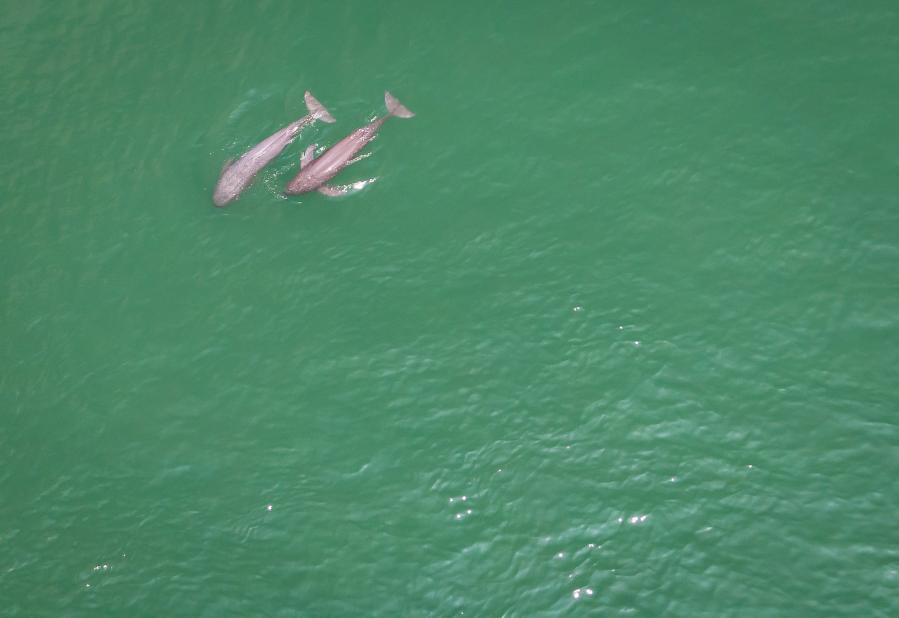Endangered "smiling angel" spyhopping Asia's longest river
2021-05-12 10:36:11 来源: Xinhua 责任编辑: 陈佳丽|
-- The freshwater porpoise with no dorsal fin is native to China and has lived here for 25 million years. They are the only freshwater subspecies of the finless porpoise family and pulse through the middle and lower main streams of the Yangtze River. -- Before 2015, only two to three finless porpoises had been spotted in the Yichang section, but scenes of the rare mammals popping out and gulping for air are becoming more common in recent years. -- On Feb. 4, 2021, China revised its list of endangered wild animals, elevating the conservation of 65 types of wild animals, including the Yangtze finless porpoise, to the strictest level-one protection from second-highest.
Aerial photo taken on May 11, 2021 shows two Yangtze finless porpoises swimming in the Yichang section of the Yangtze River, central China's Hubei Province. (Xinhua/Xiao Yijiu) WUHAN, May 11 (Xinhua) -- A pod of the Yangtze finless porpoise has been seen spyhopping above the silvery surface of the Yangtze River, China's longest river, attracting shutterbugs and nearby residents who want to catch a glimpse of these beautiful creatures. The freshwater porpoise with no dorsal fin is native to China and has lived here for 25 million years. They are the only freshwater subspecies of the finless porpoise family and pulse through the middle and lower main streams of the Yangtze River. With its mouth fixed in a permanent grin, the rotund finless porpoise is known in China as a "smiling angel." "The finless porpoise we saw Monday afternoon here in Yichang might belong to one or two groups. The porpoise tend to chase after schools of fish, so the areas they appear in must be rich in fish and other aquatic resources," said Zou Li with the bureau of agriculture and rural affairs in the city of Yichang, central China's Hubei Province. "Before 2015, only two to three finless porpoises had been spotted in the Yichang section, but scenes of the rare mammals popping out and gulping for air are becoming more common in recent years," said Zou. "The fundamental reason for the increase in sightings is more plentiful fish stock in the whole Yichang section of the Yangtze River."
Aerial photo taken on May 11, 2021 shows a Yangtze finless porpoise swimming in the Yichang section of the Yangtze River, central China's Hubei Province. (Xinhua/Xiao Yijiu) The population of the aquatic mammal experienced a sharp decrease over the past decades due to overfishing and excessive human activities. The latest research on finless porpoise conducted by the Ministry of Agricultural and Rural Affairs in 2017 showed that there was a wild population of just 1,012 still navigating the twists and turns of the longest river in Asia, even fewer than the giant panda. The annual decline of its population was 13.7 percent in the 2006-2012 period, while the drop slowed to 10 percent between 2012-2017.
Two Yangtze finless porpoises are seen at the Yichang section of the Yangtze River, central China's Hubei Province, May 10, 2021. (Xinhua/Xiao Yijiu) "However, the species is still extremely endangered at present, and the country needs to enhance protection for Yangtze finless porpoises," said Yu Kangzhen, vice minister of agricultural and rural affairs at the press conference of the 2017 survey, citing measures including regular inspections, promoting ex situ conservation and researching artificial breeding. In January 2018, a fishing ban was implemented in 83 aquatic nature reserves across Hubei to restore the ecological environment and protect the endangered species in the Yangtze River basin.
Members of a finless porpoise protection team patrol on the Yangtze River in Anqing, east China's Anhui Province, Dec. 16, 2020. (Xinhua/Zhou Mu) To further preserve biodiversity along the river, China in January 2020 implemented a full fishing ban in 332 conservation areas in the Yangtze River basin. The move has later been expanded to a 10-year moratorium for the river's main streams and major tributaries from Jan. 1, 2021. On Feb. 4, 2021, China revised its list of endangered wild animals, elevating the conservation of 65 types of wild animals, including the Yangtze finless porpoise, to the strictest level-one protection from second-highest.
A Yangtze finless porpoise is seen at the Yichang section of the Yangtze River, central China's Hubei Province, May 11, 2021. (Xinhua/Xiao Yijiu) The slew of measures has brought the "smiling angels" back into the limelight. Staff at the local fishery administration in Yichang even filmed footage of the finless porpoise hunting fish shoal recently, the first such scene they have ever shot. "Such a scene indicates that the population of finless porpoise is recovering," said a staffer. |









